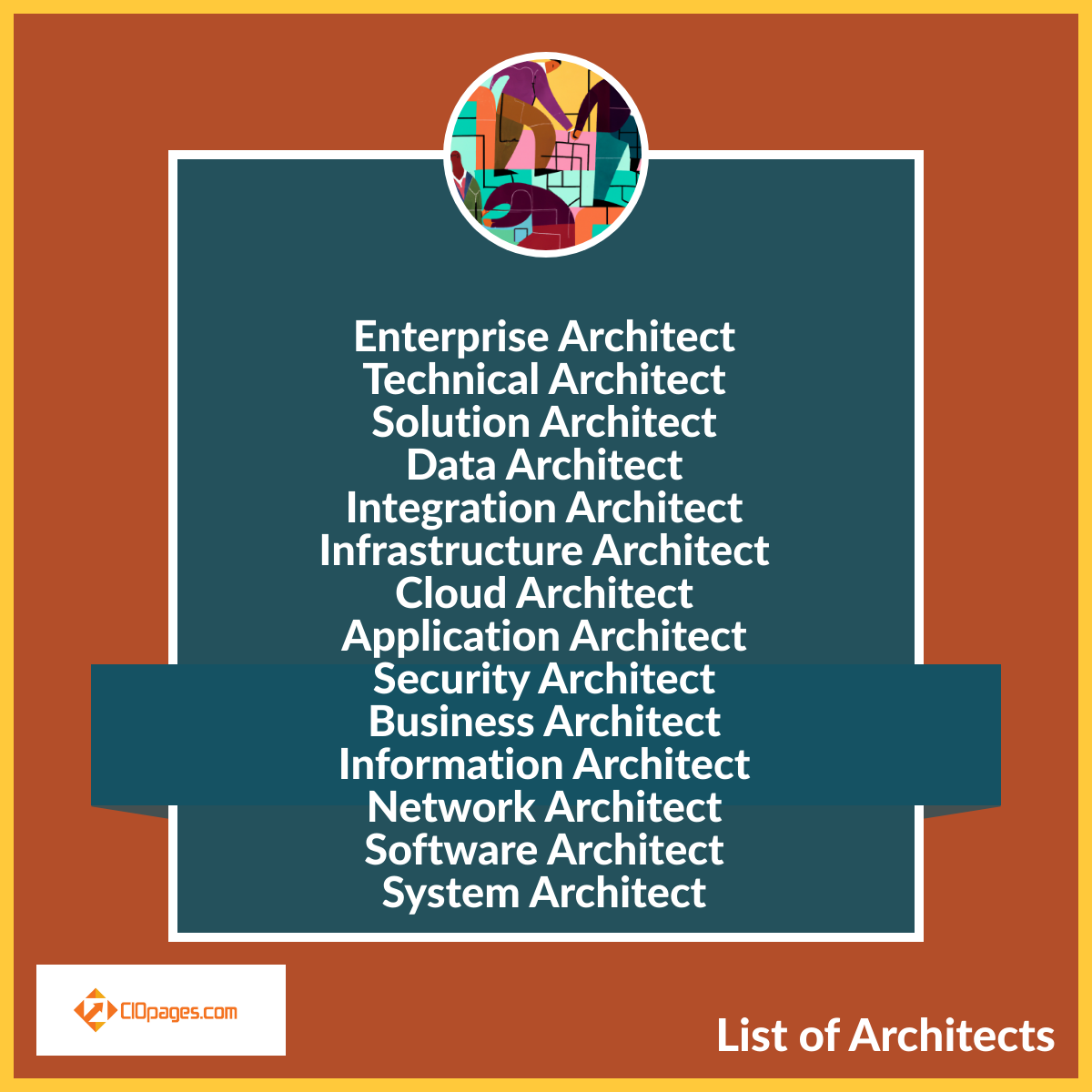Architect Roles
By: A Staff Writer
Updated on: Aug 29, 2023

Here is a comprehensive list of architect roles in an enterprise.
Architect Roles in an Enterprise
- Enterprise Architect
- Technical Architect
- Solution Architect
- Data Architect
- Integration Architect
- Infrastructure Architect
- Cloud Architect
- Application Architect
- Security Architect
- Business Architect
- Information Architect
- Network Architect
- Software Architect
- System Architect
A Brief Overview of Each of the Architect Roles
1. Enterprise Architect
Roles and Responsibilities: The Enterprise Architect is responsible for aligning the organization’s business strategy with its technology. They provide a high-level, holistic view, often constructing enterprise architecture frameworks to guide technology decisions across the company.
Fundamental Qualifications and Competencies:
- Master’s degree in IT, business, or related field
- Familiarity with TOGAF, Zachman or FEAF frameworks
- Strong analytical and communication skills
2. Technical Architect
Roles and Responsibilities: The Technical Architect focuses on high-level design choices and dictates technical standards, including software coding standards, tools, and platforms. They are often hands-on in system development and code reviews.
Fundamental Qualifications and Competencies:
- Bachelor’s degree in Computer Science
- Proficiency in multiple programming languages
- Problem-solving abilities
3. Solution Architect
Roles and Responsibilities: Solution Architects are responsible for converting requirements into the architecture and design that guide the final solution. They work closely with stakeholders and development teams.
Fundamental Qualifications and Competencies:
- Knowledge of domain-specific technologies
- Skilled in risk management
- Bachelor’s or Master’s degree in a relevant field
4. Data Architect
Roles and Responsibilities: Data Architects define how data will be stored, consumed, integrated, and managed across the organization. They often develop data models and database designs.
Fundamental Qualifications and Competencies:
- Experience with relational databases and data modeling tools
- Bachelor’s degree in Data Science or related field
- Analytical thinking
 5. Integration Architect
5. Integration Architect
Roles and Responsibilities: Integration Architects focus on how software applications and computing systems communicate with each other. They define the data flow across multiple applications.
Fundamental Qualifications and Competencies:
- Experience in middleware technologies and API integrations
- Good problem-solving skills
- Degree in Computer Science or IT
6. Infrastructure Architect
Roles and Responsibilities: Infrastructure Architects are responsible for the IT infrastructure of an organization, including the data center, networking, and cloud computing resources.
Fundamental Qualifications and Competencies:
- Familiarity with network architectures and cloud solutions
- Good organizational skills
- Bachelor’s degree in IT or related field
7. Cloud Architect
Roles and Responsibilities: Cloud Architects focus specifically on cloud computing strategies, including planning, design, implementation, and maintenance.
Fundamental Qualifications and Competencies:
- Certifications in AWS, Azure, or GCP
- Deep understanding of cloud computing
- Strong communication skills
8. Application Architect
Roles and Responsibilities: Application Architects define the architectural approach and coding standards for specific applications. They also often lead development teams.
Fundamental Qualifications and Competencies:
- Proficiency in backend and frontend development
- Bachelor’s degree in Software Engineering or related field
- Leadership skills
9. Security Architect
Roles and Responsibilities: Security Architects focus on designing secure IT systems. They are often involved in risk assessments and security protocols.
Fundamental Qualifications and Competencies:
- Certifications like CISSP, CISM
- Strong knowledge of cybersecurity
- Bachelor’s degree in Information Security or related field
10. Business Architect
Roles and Responsibilities: Business Architects focus on the organizational strategy, governance structures, and business processes.
Fundamental Qualifications and Competencies:
- Master’s degree in Business or MBA
- Understanding of business strategy and operations
- Strong leadership qualities
11. Information Architect
Roles and Responsibilities: Information Architects focus on the human-computer interaction aspect of systems. They create the structure and design around how information is presented and accessed.
Fundamental Qualifications and Competencies:
- Background in UX/UI Design
- Strong communication skills
- Degree in Design or HCI
12. Network Architect
Roles and Responsibilities: Network Architects design and build data communication networks such as LANs and WANs.
Fundamental Qualifications and Competencies:
- Certifications like CCNA, CCNP
- In-depth knowledge of network protocols
- Bachelor’s degree in Network Engineering
13. Software Architect
Roles and Responsibilities: Software Architects provide a software framework that allows a business to meet its objectives and constraints for functionality, reliability, and performance.
Fundamental Qualifications and Competencies:
- Degree in Software Engineering
- Proficiency in multiple programming languages
- Strong problem-solving skills
14. System Architect
Roles and Responsibilities: System Architects develop system architectures that align with business goals. They often work closely with enterprise architects to deploy scalable solutions.
Fundamental Qualifications and Competencies:
- Master’s degree in Systems Engineering
- Familiarity with UML or other modeling tools
- Strong analytical skills
Each role is crucial for the successful execution of projects in modern enterprises. These roles often collaborate, as many of the competencies and responsibilities are interrelated. Understanding these roles could offer valuable insights into how technology and business strategies converge.
Did we miss any architect roles? If so, please share them with us.